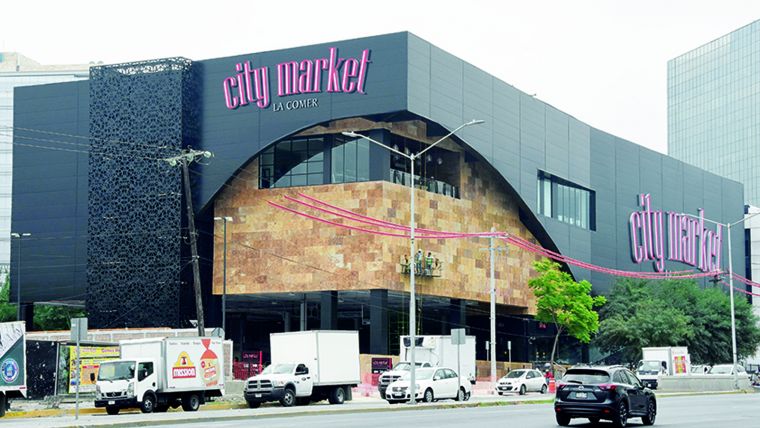Illustrative image City Market Nuevo León
In 2005 the building where the Pollo Feliz restaurant was located was too small, so it was relocated across the street, and the old space was used for the construction of La Comercial Mexicana (La Comer) supermarket. Pollo Feliz respected the local urban architecture while physically La Comer was no more than a warehouse. Due to pressure from a citizen collective called Basta Ya, in 2006 the city administration tried to make the architecture adapt to the city’s style, but it was only able to obtain the facade that only covers two sides of the warehouse, as the construction permits had already been issued.
In addition to these two projects of La Comer and Pollo Feliz, a third one was intended for the site where for many years Motel La Siesta provided lodging services but was demolished more than a decade ago. Rumors spread like wildfire: a Walmart would be built there, then not; instead it would be a Costco. The rumors ended recently with the confirmation that City Market will be built. According to the local government, the construction will follow the architectural standards of San Miguel.
City Market
A couple of months ago, metal sheets were placed around the Salida a Celaya almost at El Pípila Underpass (formerly the Glorieta). The first stage of construction was excavation. It is now clear that the project is the construction of a City Market.
Francisco García, director of San Miguel’s Heritage and the Historical Center, said that the project was authorized almost on a de facto basis, and that in the Urban Development Plan and Territorial Order 2040, the area had been set aside as a commercial area. In other words, “any store could have been installed there.”
García stated, “Those who acquired the property are building a City Market store. A store of the highest La Comer quality.” He added that in addition to the store, the space will contain other commercial spaces and parking.
From an architectural perspective, García stated that the store will sit on 2.1 hectares, have a construction area of 9,125 square meters, and should have 86 parking spaces because that “is the requirement,” but will in fact have 274 spaces.
Regarding height, he indicated that the structure will be a maximum of 10 meters high, and the warehouse will not be visible, as it is in the case of La Comer, because “the facade will be made with materials and design according to San Miguel de Allende style.” He clarified that the roof will not be beautified because it is enough to go up on any roof to see the dome of places such as the old Ford building and the old Hermanos Aldama cinema downtown, among other places.
Central Zone Expansion
García spoke with Atención about the La Comer project but he first recalled that in February 2020 city council decided to expand the radius of his department’s reach.
According to the city government, the proposed expansion of the Historical Center (previously under the Urban Development Department) aims to achieve an integrated image “so that locals and visitors perceive the congruence and harmony of these areas with the Historical Center, Monument Zone, and the area declared a World Heritage Site.”
To achieve the idea, the “downtown” area was expanded to include the Aurora, Valle del Maíz, Guadalupe, and San Antonio neighborhoods, as well as the entryways to the city, which include Salida a Celaya, from Stirling Dickinson to underpass; Salida a Querétaro, from the Hotel Misión to the intersection with Libramiento Manuel Zavala and Paseo de los Conspiradores; and finally Calzada de la Estación, from the Guanajuato Bridge to the Bicentennial Bridge. “The building heights, the color palette, the type of advertisements will be integrated,” said García.
When the decision was made to include the above neighborhoods, the administration stated that the action sought to “…establish a coherent and harmonious balance between local economic activity, the landscape, and the urban image, trying to avoid any intention, use, project, or action in any area, property, education or facility that degrades or deteriorates the urban image or distorts the appreciation of the cultural, urban, and architectural heritage.”
In 2019, the budget for maintenance and preservation of the Historic Center was 8 million pesos. García indicated that the benefits of the expansion are painting facades, new placement of nomenclature (street names, signage, etc.), and an improved urban image.
He was clear that the people who live in the above-mentioned areas would not have to go to the National Institute of Anthropology and History (INAH) to process building permits, and that INAH would not intervene in the neighborhoods, but that “they will be treated with a similar criteria at the local level, in order to integrate them into the theme of the Historic Center.”
City Market is part of the La Comer conglomerate, which has 33 branches, 15 Fresko stores, 13 SuMesa stores, and 12 City Market stores. Currently, the closest City Market is in Querétaro.
Atención contacted La Comer personnel to learn about investment for the project in San Miguel, how many jobs would be created, and an estimated completion date for the project. We were told that the information would be provided shortly.

